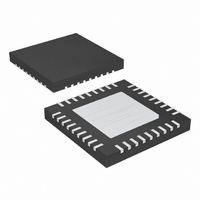MAX9742ETX+ Maxim Integrated Products, MAX9742ETX+ Datasheet - Page 18

MAX9742ETX+
Manufacturer Part Number
MAX9742ETX+
Description
IC AMP AUDIO PWR 20.5W D 36TQFN
Manufacturer
Maxim Integrated Products
Type
Class Dr
Datasheet
1.MAX9742ETX.pdf
(36 pages)
Specifications of MAX9742ETX+
Output Type
2-Channel (Stereo)
Max Output Power X Channels @ Load
20.5W x 2 @ 8 Ohm
Voltage - Supply
20 V ~ 40 V, ±10 V ~ 20 V
Features
Depop, Differential Inputs, Mute, Short-Circuit and Thermal Protection, Shutdown
Mounting Type
Surface Mount
Package / Case
36-TQFN Exposed Pad
Product
Class-D
Output Power
16 W
Thd Plus Noise
0.08 %
Supply Current
15 mA
Maximum Power Dissipation
2.86 W
Maximum Operating Temperature
+ 85 C
Mounting Style
SMD/SMT
Audio Load Resistance
4 Ohms
Minimum Operating Temperature
- 40 C
Lead Free Status / RoHS Status
Lead free / RoHS Compliant
Single-/Dual-Supply, Stereo 16W,
Class D Amplifier with Differential Inputs
Figure 6 shows the MAX9742 configured as a summing
amplifier, which allows multiple audio sources to be lin-
early mixed together. Using this configuration, the out-
put of the MAX9742 is equal to the weighted sum of the
input signals:
As shown in the above equation, the weighting or
amount of gain applied to each input signal source is
determined by the ratio of R
resistor (R
source. Select R
of the MAX9742 is not exceeded when the input signals
are at their maximum values and in phase with each
other (see the Output Dynamic Range section).
To minimize output offset voltages due to input bias
currents, connect a resistor, R
between IN_+ and MID. Select the value of R
that the DC resistances looking out of inputs of the
amplifier (IN_+ and IN_-) are equal. For example, when
using the dual-supply configuration with a DC-coupled
input source, the value of R
R
Figure 6. Summing Amplifier Configuration
18
F
V
||R
OUT_
______________________________________________________________________________________
IN1
Summing Configuration (Audio Mixer)
||R
= −
IN2
IN1
|| ||R
(V
, R
V
IN1
IN1
F
IN2
INn
and R
R
, R
.
R
IN1
F
V
IN3
IN2
IN_
+
) connected to each signal
V
so that the dynamic range
F
IN2
and the respective input
OS
V
IN3
R
R
should be equal to
OS
IN2
F
, (see Figure 6)
+
C
C
C
IN
IN
IN
V
IN3
R
R
R
IN1
OS
R
IN2
IN3
R
IN3
F
such
R
OS
)
MID
IN_-
IN_+
V
The MAX9742 also accommodates a mono bridge-tied-
load (BTL) configuration that can be used in single-
supply and dual-supply applications. In the BTL
configuration, the speaker load is driven differentially
by connecting the half-bridge outputs as a full H-bridge
driver. To drive the speaker differentially, the inputs of
both channels must be driven by the same audio signal
with one channel 180° out-of-phase with the other
channel. Figure 7 shows the connections required for
BTL operation.
The advantages of BTL operation include reduced
component count due to the elimination of the output-
coupling capacitors when using single-supply opera-
tion, a 6dB increase in gain due to the load being
driven differentially, increased output power into a sin-
gle load, and the minimization of the supply-pumping
since each half bridge is driven 180° out-of-phase (see
the Supply Pumping Effects section). For single-supply
applications, the output-coupling capacitors are not
needed for BTL operation since the DC voltage present
at each half-bridge output is equal in value and applies
to each side of the load. This means no DC voltage
appears across the load, and therefore, no DC current
flows into the speaker.
OUT_
(V
C
R
FB_
IN1
F
MAX9742
R
R
IN1
F
× V
IN2
R
R
IN2
F
FB_
× V
Mono Bridge-Tied-Load (BTL)
IN3
TO CLASS D
MODULATOR
OUT_
R
R
IN3
F
)
Configuration












